Portable virtual reality glasses and some thoughts
Under the cut, just regular virtual reality glasses (hereinafter referred to as BP), based on the phone, but that fit in a bag and even a pocket. And a few more thoughts about the current BP.
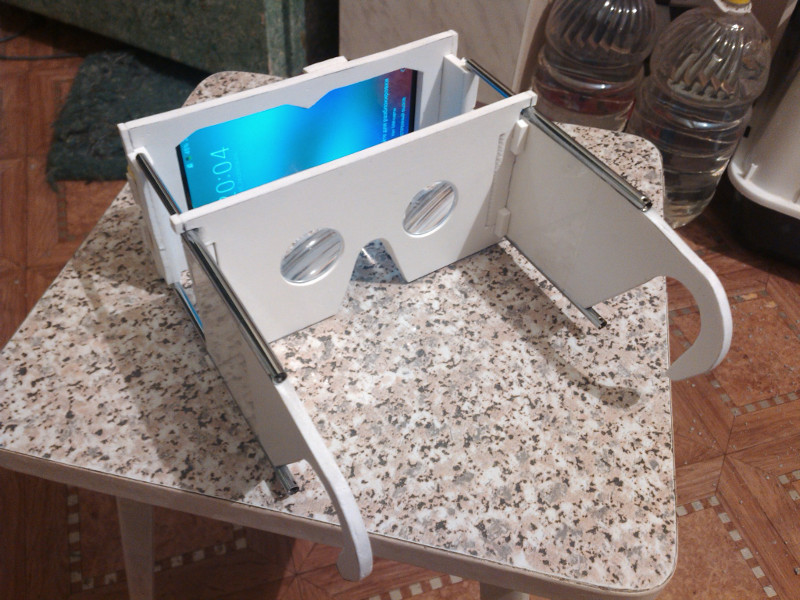
')
Two years have passed since my previous and first publication, in which I described my BP glasses made from a swimming mask and a tablet. Since then, many different versions have already been released, and very few people can be surprised by the next points of BP. But I don’t understand one thing: if there are glasses for mobile devices, then why are the glasses themselves always so big? This thought (and not only this one) pushed me to create the next data points of BP.
Just want to apologize for a not very technical language, confusion in some moments, incoherent speech. Many thoughts come precisely at the time of writing, not to think over everything in advance.
And perhaps I'll start with the story of how I came to these points. If someone is not interested, you can skip this spoiler.
Reflections on the design took about two months. Every day, the head gave out some new ideas and rejected old ones. Initially, it was generally planned to give everything to 3D printing, but the price would have resulted in about 6,000 r and any improvements would have to be sent back to print. And I'm lazy and did not want to bother with it all. Yes, and the original version generally included gears and was much more complicated than the current one, so the refusal of 3D printing provoked brain activity to think through a simpler design.
I will describe the manufacturing process not as an instruction, but as a story, for there have been changes that are not consistent with previous actions.
Accessories include:
1. Plastic from foamed pvc 5 mm thick (not in the photo).
Such plastic is commonly used in advertising. Bought at the store selling materials for advertising. Excellent cut, processed and at the same time quite durable. A square meter cost me 700 rubles. Although it takes much less for glasses, I took it for the future. Before that I tried all sorts of different plastics, but this is the only one with which it is comfortable to work.
2. Antennas for radio.
For a piece I gave 120 r, and I need 4 of them. I think it's expensive. They will act as a sliding mechanism.
3. Lenses from loupes NoName Made In China.
They do not even indicate the multiplicity, but I choose empirically. Or to say in other words, by fitting. I take a magnifying glass in a store, hold it to my eye and look through the lens on my palm. I try on how much area is included in the review, and the approximate distance from the lens to the palm. For a piece 70 p.
4. Clips. Diameter in cross section of about 1 mm
Will serve as axes.
5. Microfiber fabric.
I want to use it as an external case. Since the glasses will fold, the body must be elastic. And while not passing light. Microfiber for wiping optics is suitable for this role almost perfectly. It is thin and dense. Light almost never misses. A cloth measuring 25x25 cm cost me 120 rubles. According to my calculations it should be enough.
6. And of course the most important thing is the telephone.
This is the most expensive of all the components and the heart of glasses. ZTE Grand S2 for 14,500 p. The criteria by which the device was chosen is the screen - 5.5 "and FullHD (1920x1080). Of course it's a pity for money, but, if anything, it will not disappear.
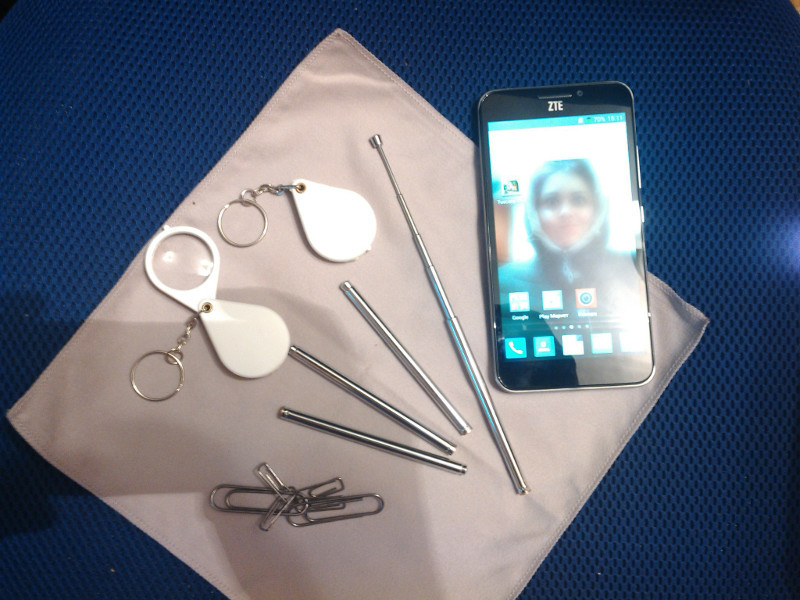
More would like to talk about the phone. Prior to this, on previous glasses, the display sizes were 7 ". Somehow I didn’t think much about choosing this size, but only when choosing a phone came the simple truth - 5.5" is ideal for my 61 mm interpupillary distance. The 5.5 "width of the screen is 122 mm, which is exactly half the interpupillary distance. Why didn’t I think about it before, I don’t know. FullHD of this phone is quite enough for a decent picture, and there’s no gap between the pixels.
And I would also like to tell you about a fictitious way to accurately determine the interpupillary distance. Although most likely this method did not know just me alone, but still. Before that, I either myself in front of the mirror, or asked someone thread to measure the distance between the pupils with a ruler. Of course there will be a big error. Firstly, the look is not parallel, and secondly, the measuring person also cannot be accurately perceived. Sometimes it happened that the distance reached 65 mm. My method is as follows: you need to take a piece of paper (preferably harder); mark on it several pairs of points that are 58, 59, 60, 61, 62 mm apart, and so on; make holes with the needle in the planned places; look at the distant object through each pair of holes. The pair in which the distant object is in the center of the holes is yours.
Like any development of new glasses, this one started with the construction of a 3D model.
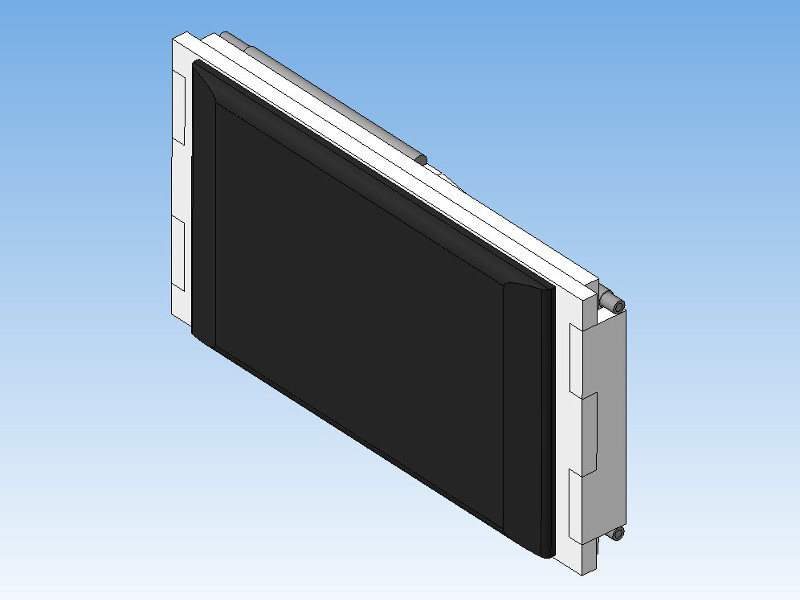

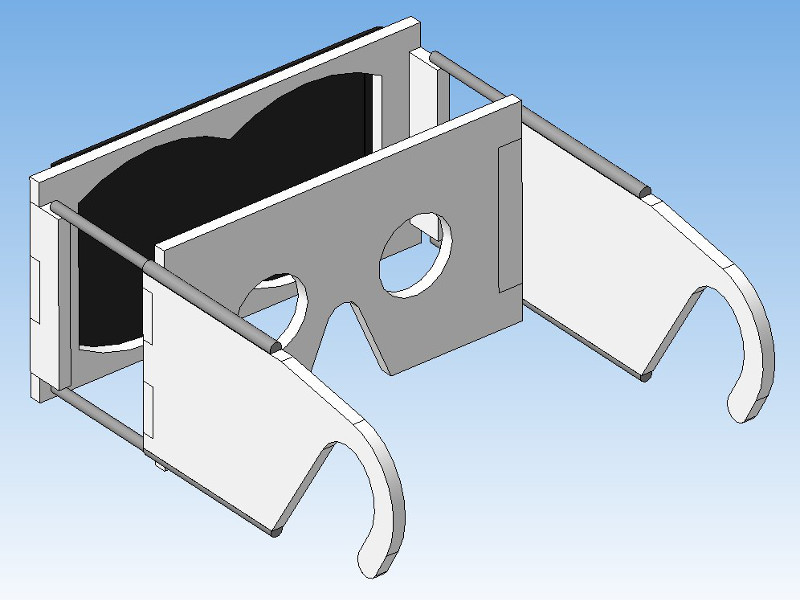
The 3D model does not contain all the elements, but is built in order to determine the basic performance of the structure, the general appearance and whether there are any intersections of the material. Well, even then you will not have to bathe with drawing the dimensions of the parts, but you can simply print on a 1: 1 scale projection of these parts, cut and transfer to plastic.
As you can see, the design mainly consists of a frame for the phone, a frame for lenses, two arms, side panels for the frame, side panels for arms and four telescopic elements. It was assumed that the form in the form of real glasses would allow using them even without removing the caps (if there is one).
I will not give the dimensions of the parts. I will leave only at the end of the publication a link to the 3D model, which can be opened by the CAD program “Compass 3D” version no less than 12. There will also be attached a drawing file for the same Compass, which can be printed 1: 1 and get what I said above .
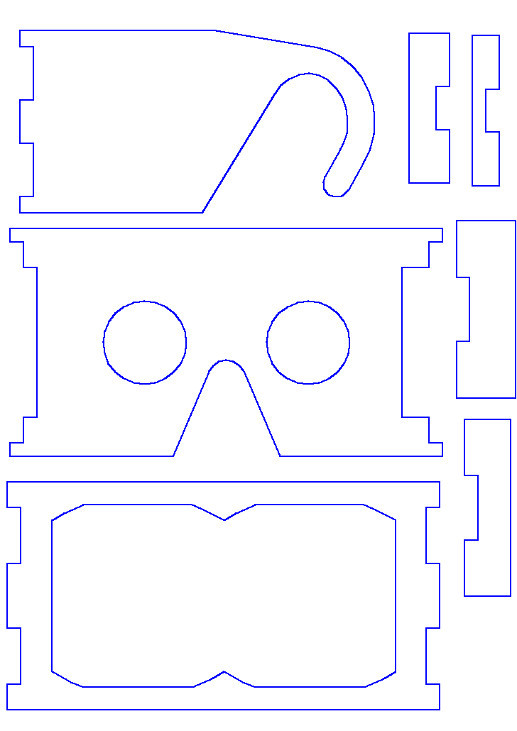
It is also worth noting that the size of the structure will vary depending on the lenses used (focal length), interpupillary distance, and head size.
As already repeated several times, I printed out the sketches and transferred to plastic. Here it is necessary to note one feature of plastic. In theory, its structure should be isotropic, but in fact it has some fibers. It turns out that in one direction plastic is hard, and in the other it bends easily enough. This feature must be considered for longitudinal structural elements.
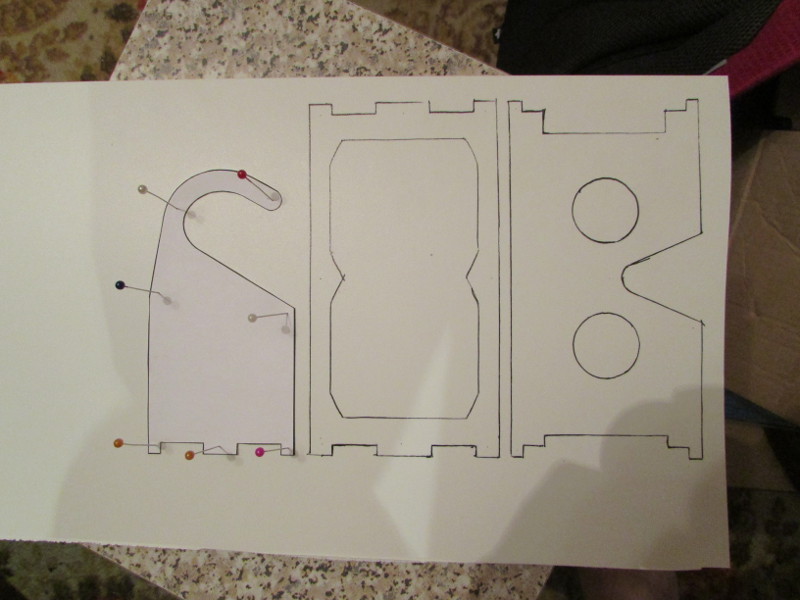
With the help of a clerical knife, everything is easily cut.
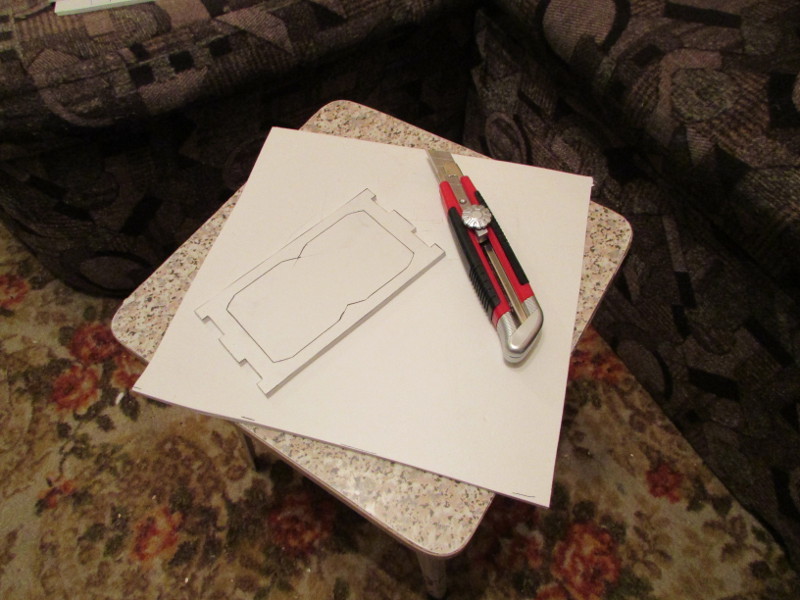

Cut perfectly, as usual, failed, so everything was adjusted to the desired size with files and sandpaper. He did this not immediately with all the details, but gradually as they were connected to each other.
Superglue stuck the sides to the frame under the phone and the bows.
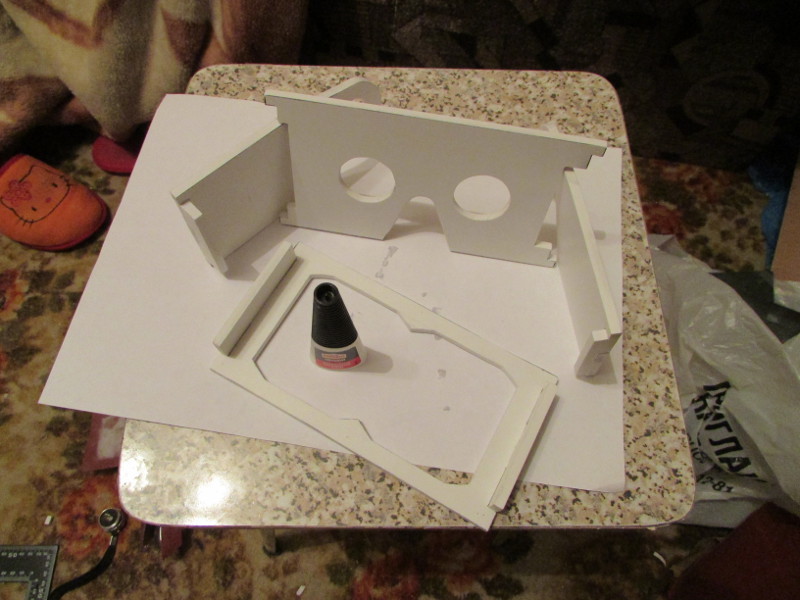
From the entire telescopic antenna is required only two knees. One of them should be 5 mm in diameter in cross section for the thickness of the plastic. With the help of an engraver with a cutting disc, I cut off the back of the antenna and the front part that was not needed. Through the ass pulled the right knee.
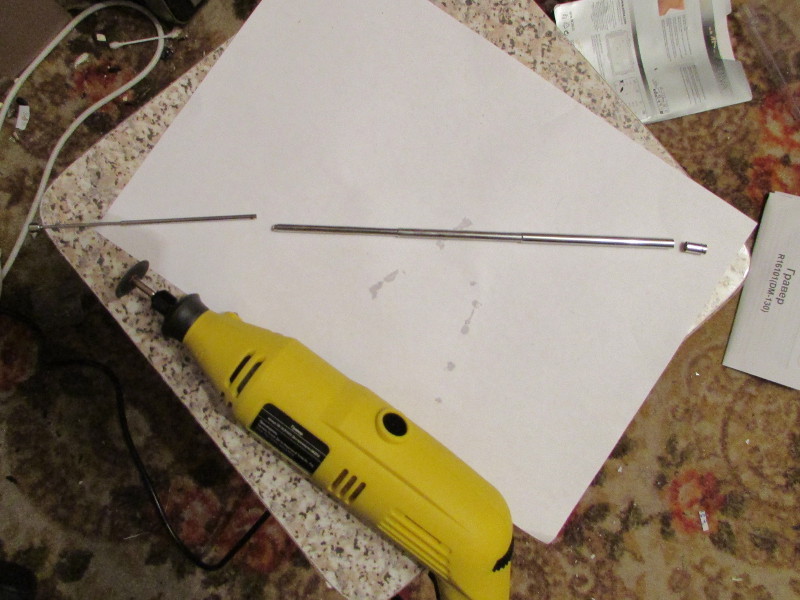
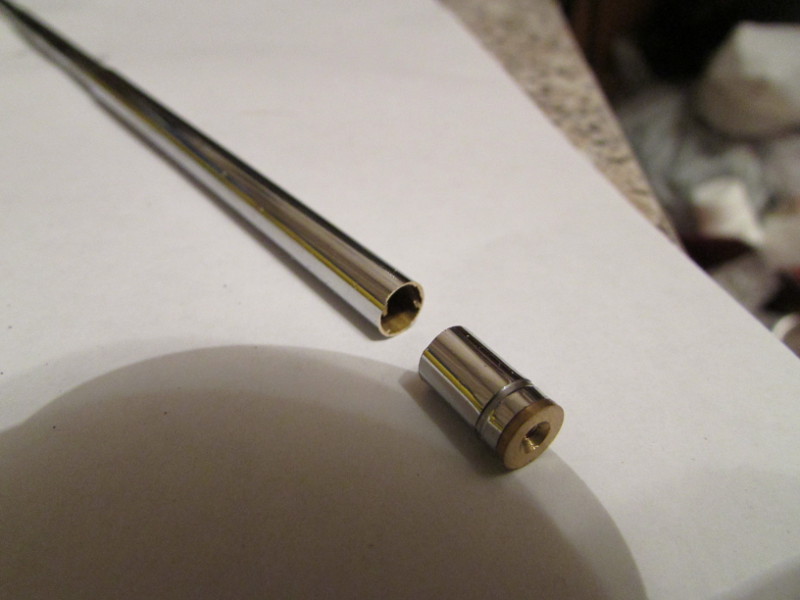

And so on all four pieces.
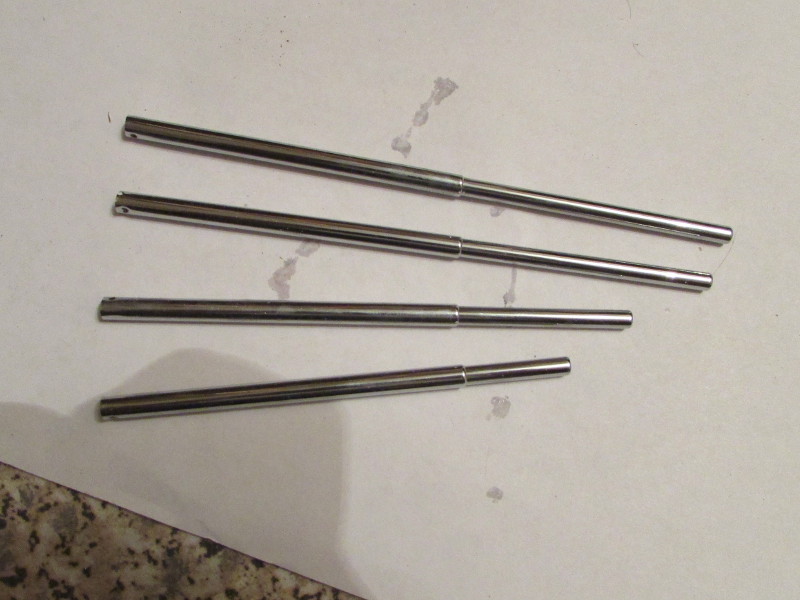
The resulting short antennas have so far been set aside and proceeded to recess on the arms with round and semi-circular needle files for these antennas.
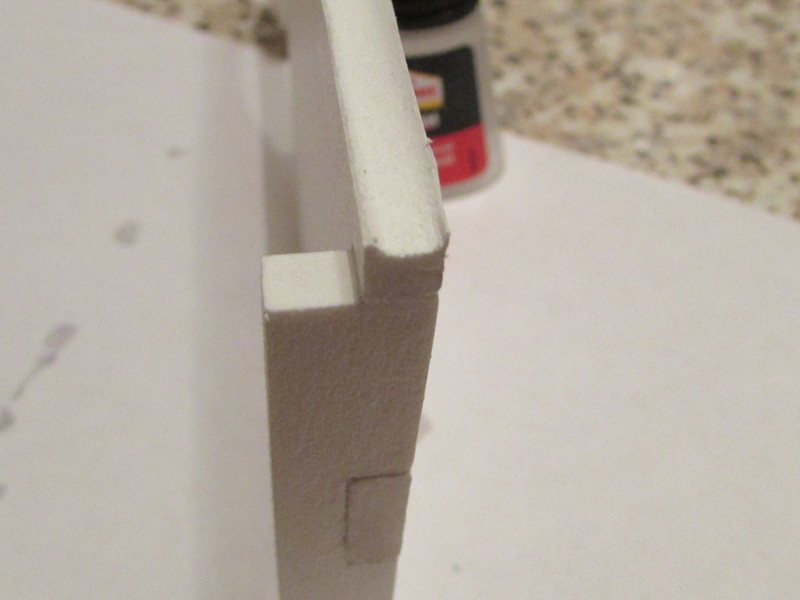
Then on the superglue stuck shortened antenna in the grooves. But the glue does not keep this whole thing very well, so I rewound it with tape too.

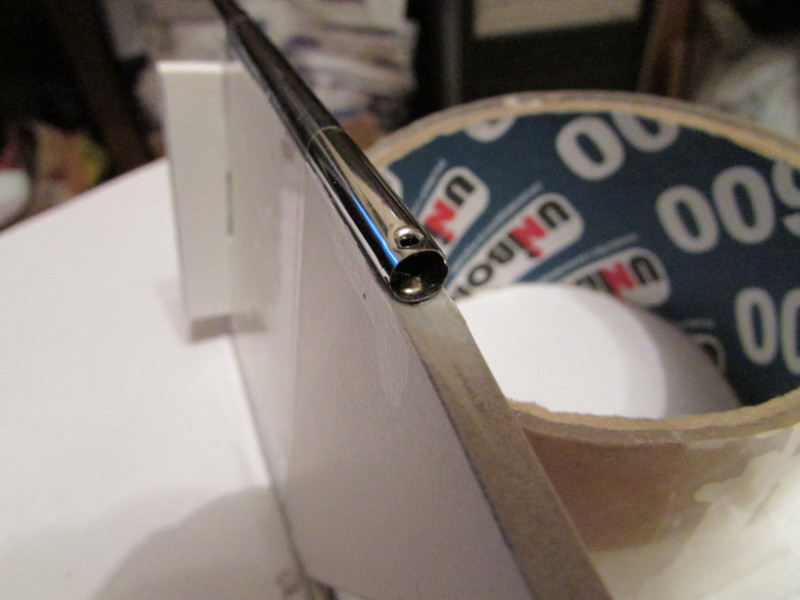
Now you need to connect the arms with a frame under the lens. To do this, with the help of the same engraver with a disc, I made grooves in the sides of the arms.
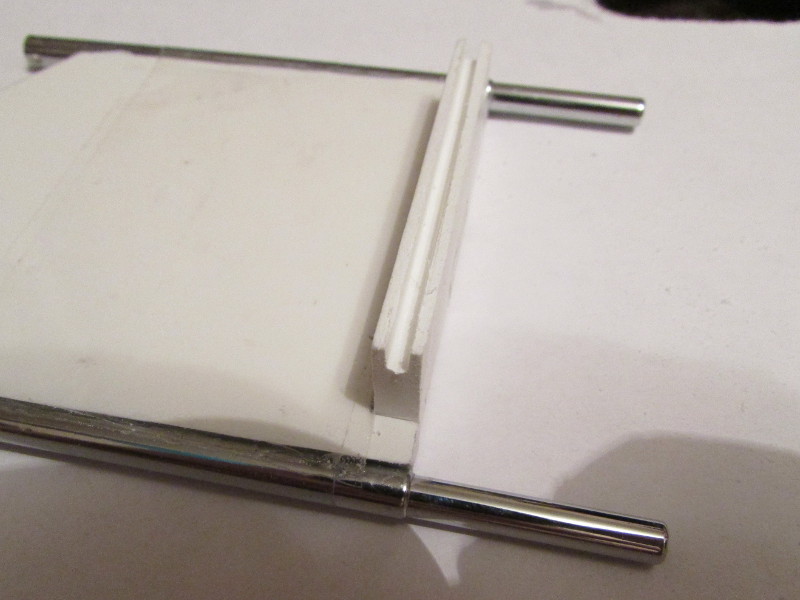
He inserted the axes into the grooves just made, dropped it with superglue and pressed one of the sides under the radius. The radius is needed so that the corner does not interfere with the rotation of the arches. As the axes successfully approached the uppermost antenna elements.
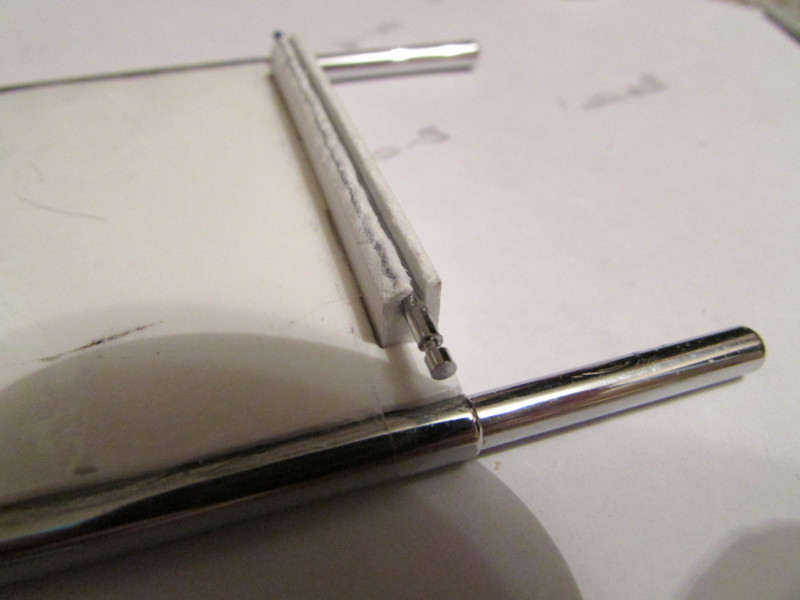
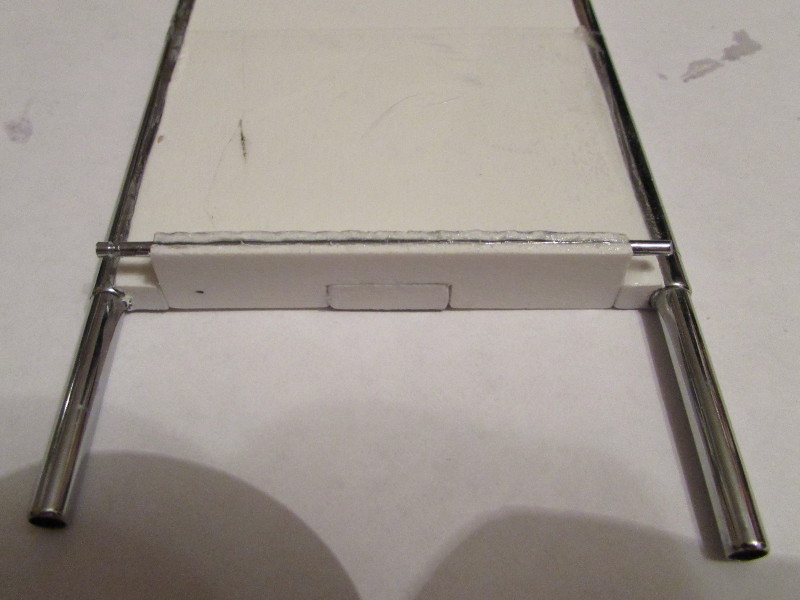
In the frame under the lens did the response grooves. Engraver and needle files.
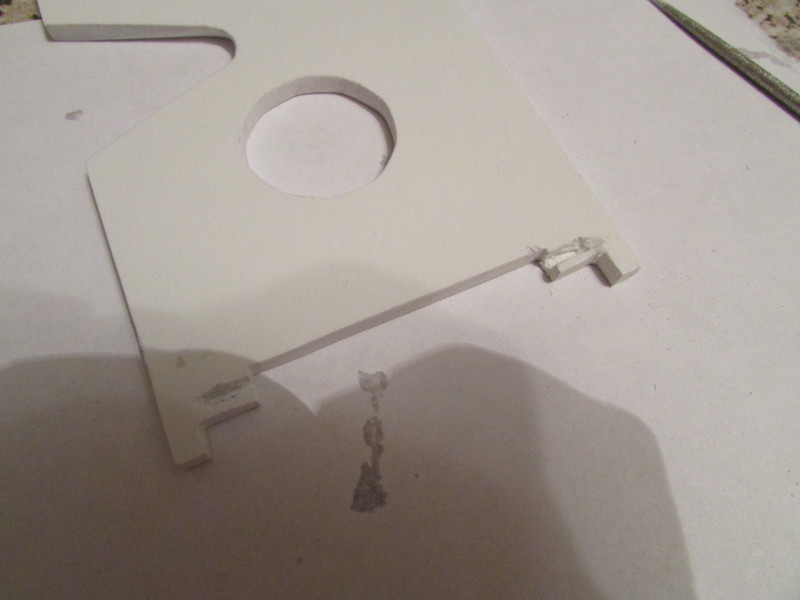
He connected the arms with the frame, inserted the axes into the grooves, dropped it with superglue and, until the glue dried, put plastic pieces on top. You can not be afraid that the axles stick tightly. All in the end is movable.
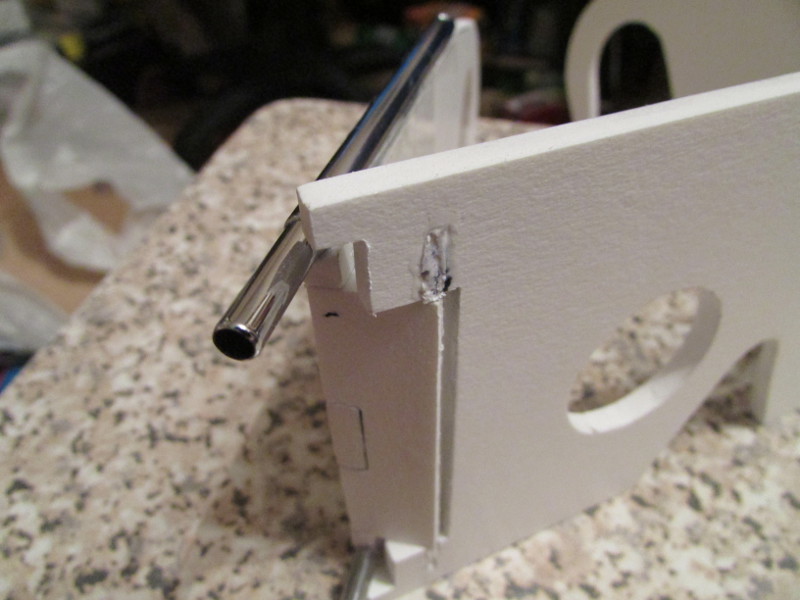

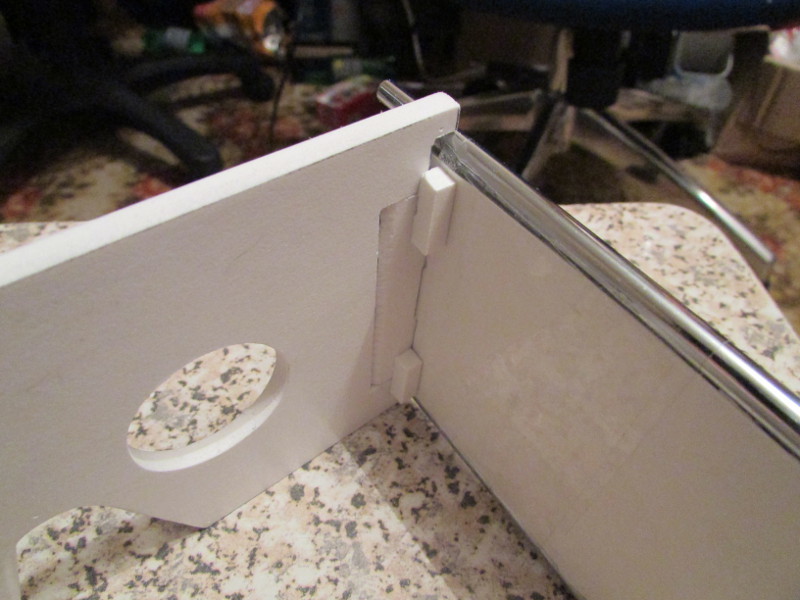


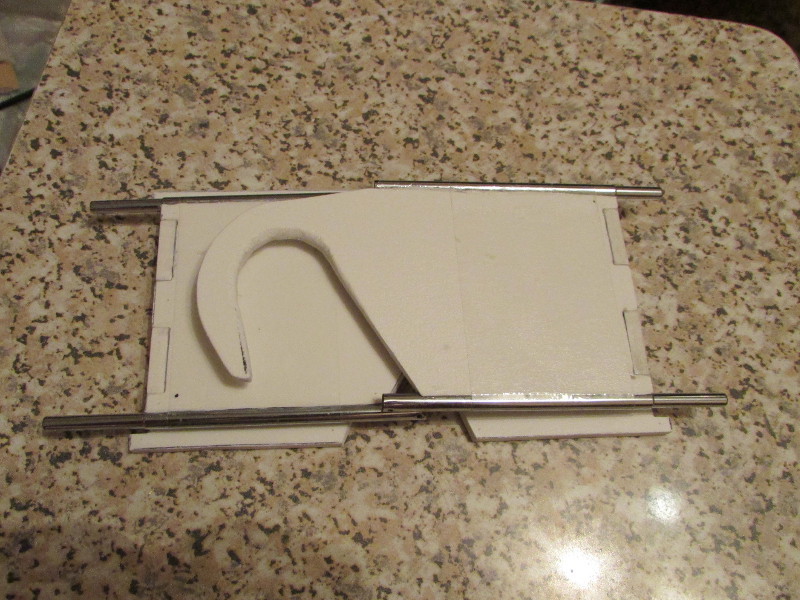
It can be seen that a couple of pieces of plastic are glued on the right bow. This is done so that when opening, the handle does not go further than it should be, i.e. to open exactly 90 degrees. On the left bow this is not required, because this, so to speak, is provided in the machine due to the fact that this bow is closer to the frame (in the closed state).
Now you need to somehow connect the resulting structure with a frame for the phone. This will help the clips that I bent, as in the pictures. Wavy ends should be inserted into the ends of the antennas.
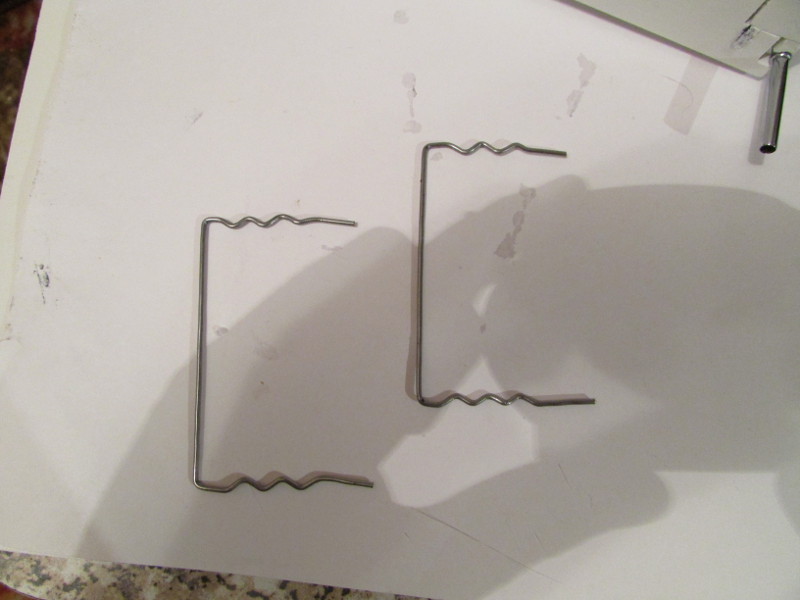
Before inserting the clips at the ends of the antennas, an engraver with a disk cut the grooves so that the clip would come out as if from a cylindrical part. This is necessary so that the ends of the antennas rest on the ends of the side frames of the frame for the phone. After slotting, he inserted the clips into the ends of the antennas and inside he poured everything with hot-melt glue. Of course, it is better to pour some glue on the thread and wait a day, but I did not want to wait. Hot-melt glue didn’t really want to climb there, quickly cooled down, blocked the passage and all subsequent portions went out through the slotted antenna groove. I had to get the iron, reheat the antenna and push the hot melt on.

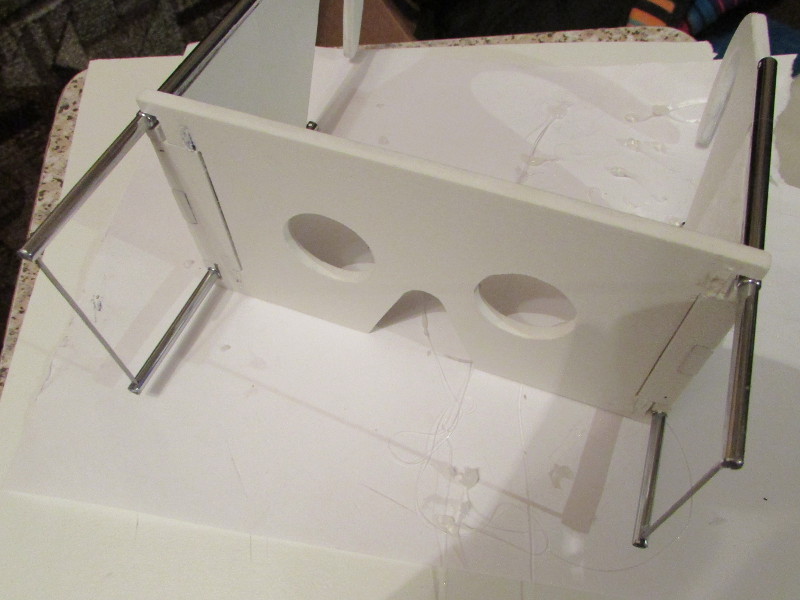
Since my hands do not grow from there, the arms were a little further from each other. And the grooves in the sides of the frame for the phone had to be done on the side, and not on the ends. If the grooves are made at the ends, then the arms during assembly of all the structures will not stand parallel to each other, which is very bad.

He put the clips into the grooves and stuck it on the superglue on top with plastic.

I thought for a long time how to fix the lenses, and in the end I decided to use the simplest option, namely, to cut the grooves with an engraver with a disk and press the lenses into these slots.
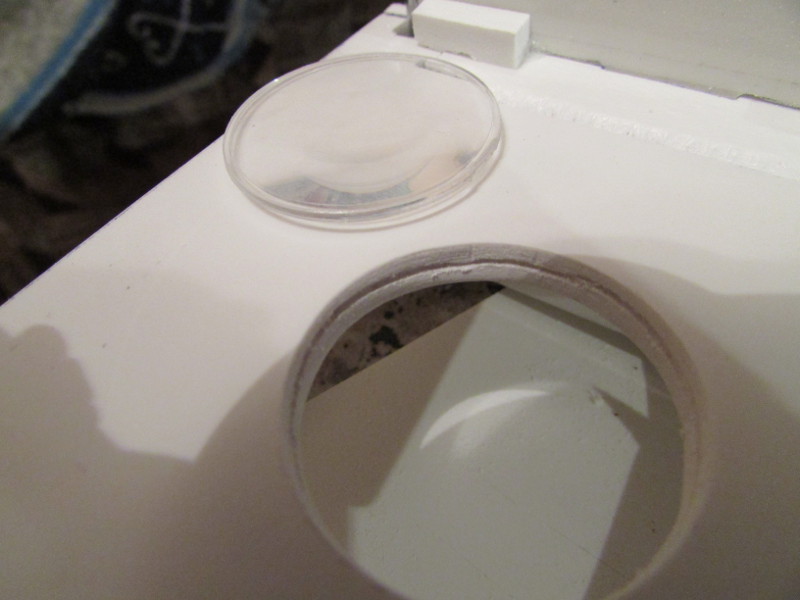
As a result, this construction was previously obtained. Another little plastic for mounting the phone and you can use it.

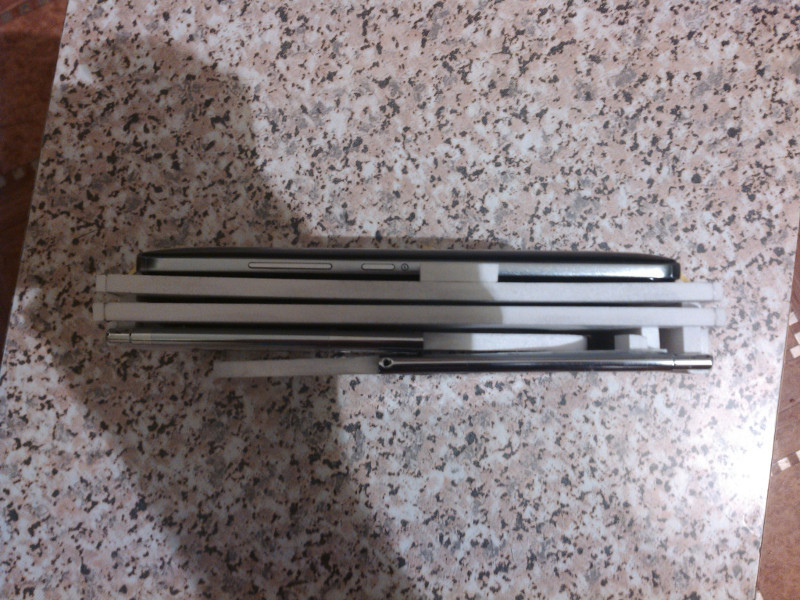
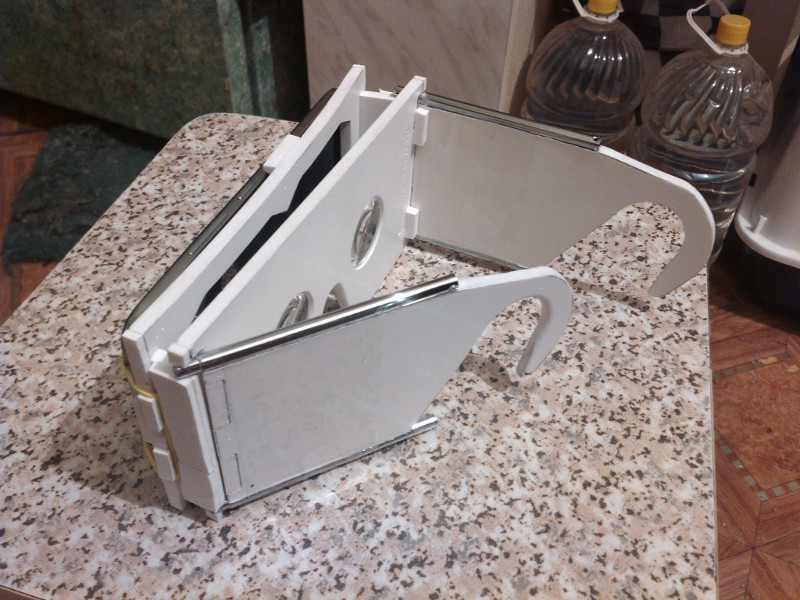



But it was not as rosy as planned. The phone even weighs only 150 grams, but it weighs heavily on the nose. And from the ears the bows slide off. I decided to use the material of a siliconized ball in order to alleviate the pressure on the nose and to eliminate slipping from the ears.

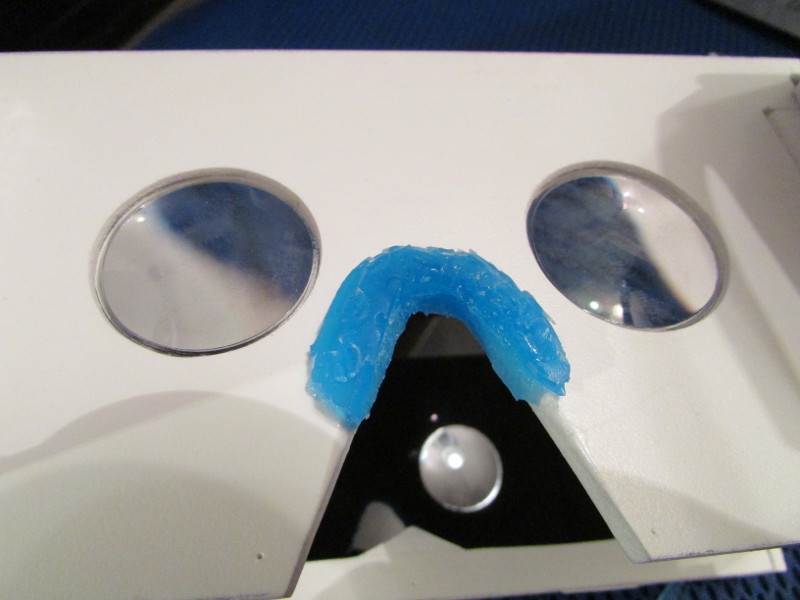
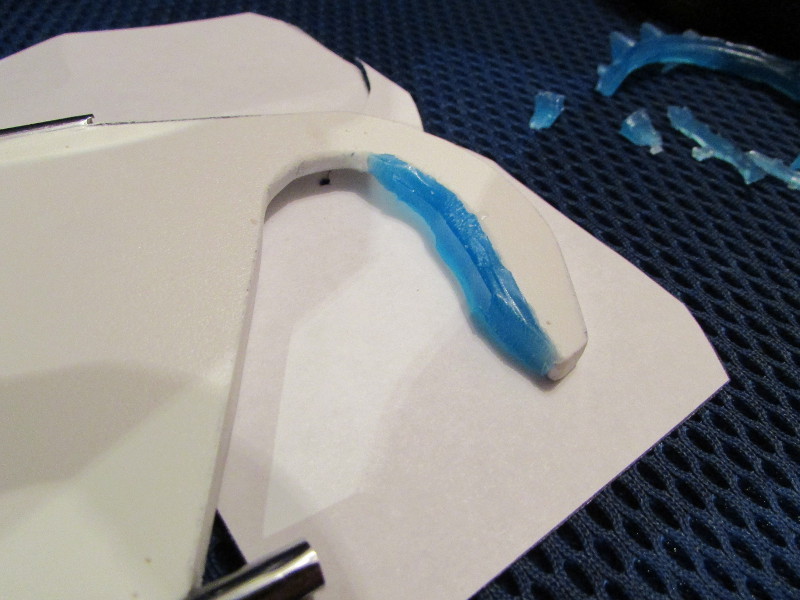
At the same time for silicone under the nose had to cut a groove in the shackle for normal closing structure. All the same engraver with the disc.

The bows really stopped slipping from the ears, but here the nose still endured unbearable pressure. I had to give up the idea of making glasses like glasses and apply a rubber over my head.To do this, cut off part of the arms, cut through the grooves, made a hole in the frame for the lenses and tied everything together with a rubber band for underwear.
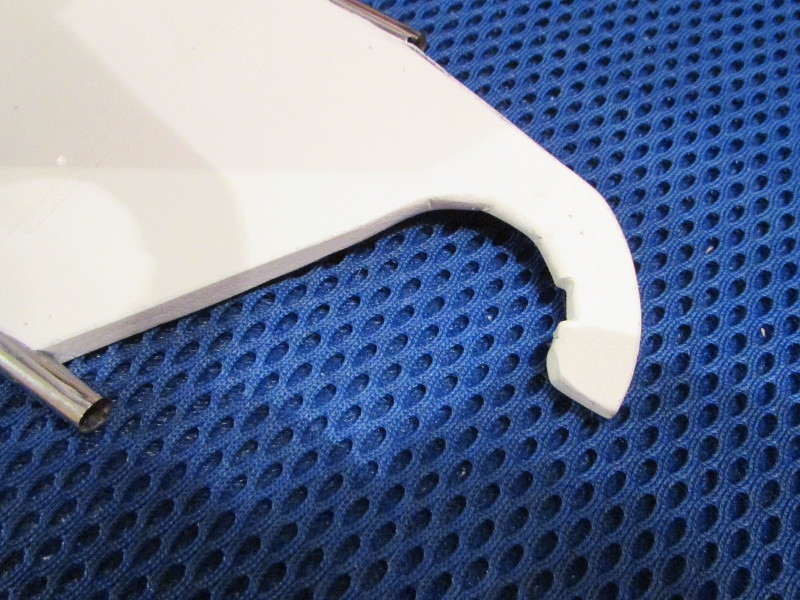



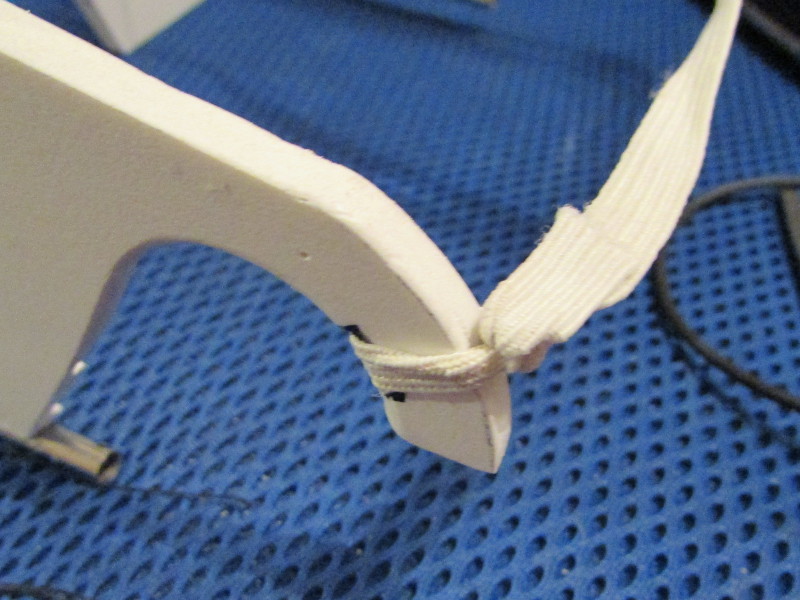
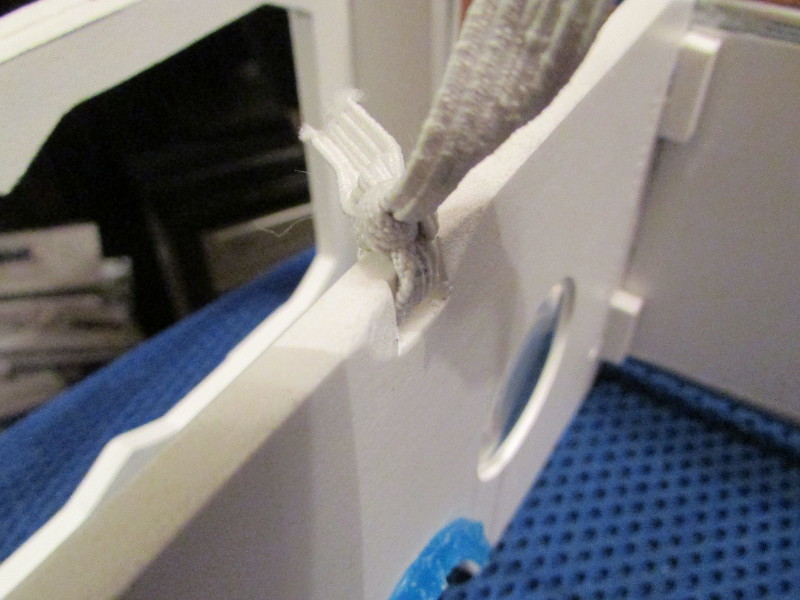
To my surprise, the resulting design has become at times more convenient and more convenient all previous points.
It remains to sew light-proof elastic body from fabric. For this, my 25x25 cm piece was cut in half, stitched into a ribbon and cut off the excess, giving shape to the face.
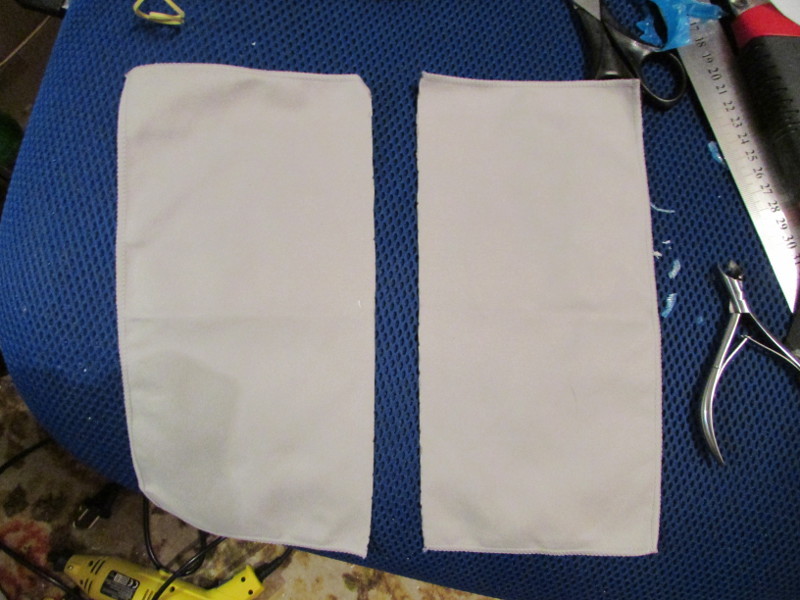

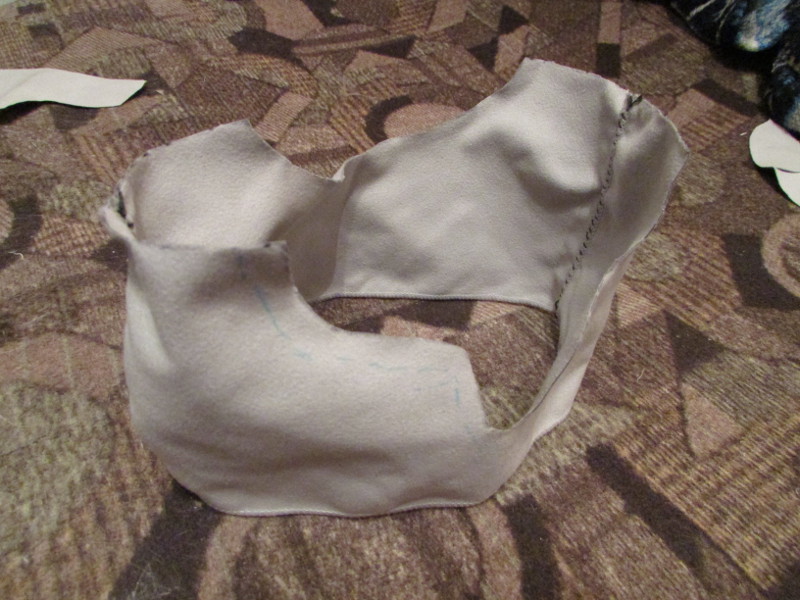
Oddly enough, the length ideally went under the perimeter of the frame. Next, the fabric is glued to both frames. Pasted on the ends at the usual time and kept the day. At the same time, the display has pulled out a certain distance from the lenses, which provides focus on the screen image. And even a little further to eventually be able to adjust the focus. I had to hem the pieces under the lower part of the face, for I hurried, but on the whole everything is fine. Next to the fabric, I sewed headphones on and that's it.

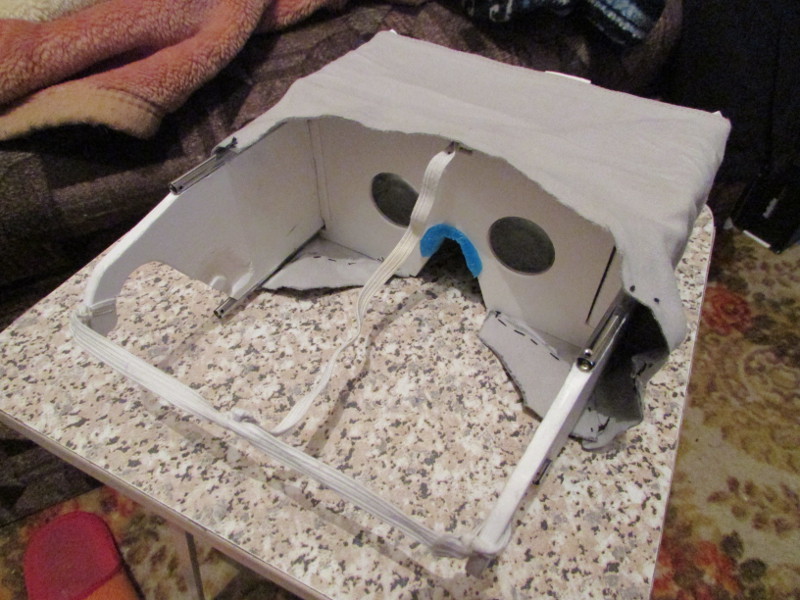

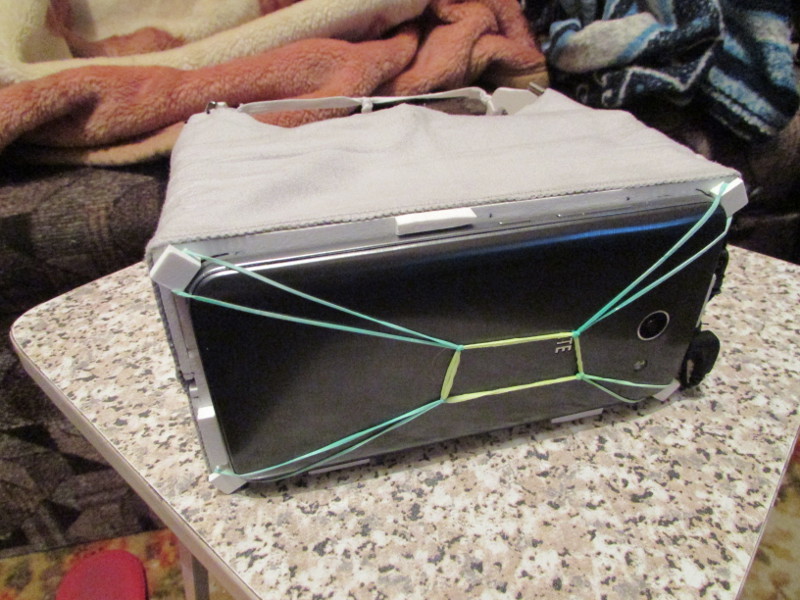
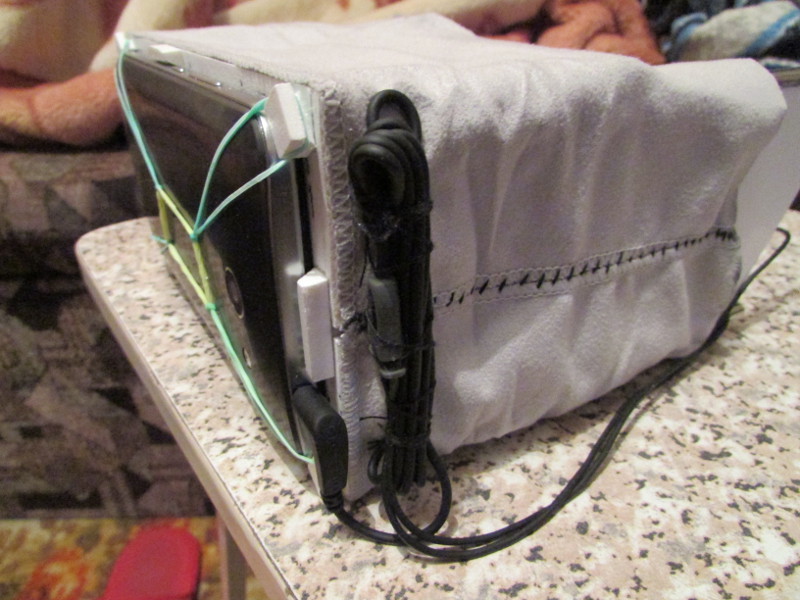
And you can still take a look at the video in which I tell about the characteristics and show how the glasses are laid out.
Well that's all. I believe that the design, although it looks careless, was a success. The most important thing is that it sits on the head easily and fairly well. In this important role played by the bow. Telescopic antennas provide rigidity and the ability to adjust the focus. Points folded out turned out:
- 35 mm in thickness;
- 180 mm in width;
- 85 mm in height;
- weighing 320 grams (150 grams of which is a telephone).
With such sizes, they easily fit in any bag or even pocket.
Now you can carry your little world with you wherever you want. The main thing is that the sockets are nearby, if you understand what I mean. In principle, I have plans for these points and even a gamepad for mobile devices has already arrived. If there is a need, then laziness will overpower. But for now I will not get ahead.
And, as promised, a link to a file with a 3D model.
And even a little information from curiosity: it took about 12 hours to prepare the materials for this article and to write it. Lots of.

')
Two years have passed since my previous and first publication, in which I described my BP glasses made from a swimming mask and a tablet. Since then, many different versions have already been released, and very few people can be surprised by the next points of BP. But I don’t understand one thing: if there are glasses for mobile devices, then why are the glasses themselves always so big? This thought (and not only this one) pushed me to create the next data points of BP.
Just want to apologize for a not very technical language, confusion in some moments, incoherent speech. Many thoughts come precisely at the time of writing, not to think over everything in advance.
And perhaps I'll start with the story of how I came to these points. If someone is not interested, you can skip this spoiler.
Story
It all started in 2013, when I learned more about the Oculus Rift and, of course, I wanted to. Then I thought that you can do something similar with the tablet, well, I did. Actually, on this occasion there is a whole publication and there is nothing special to tell here.
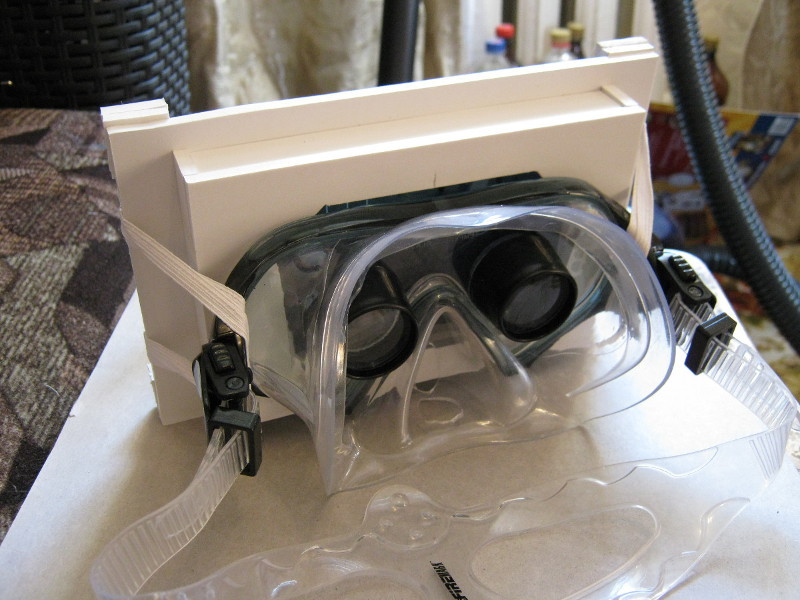
In these glasses I indulged with Minecraft through the stream via Wi-Fi, wrote my very small applications using a gyroscope, an accelerometer. The image jumped, jumped, was delayed at turns, but it worked. Perhaps the most wow sensations received from these glasses, for the first.
After some time, everything calmed down, scored points, but comrade with gamedev inspired new feats. He suggested that our narrow-eyed neighbors can order all the components to create a computer version of BP glasses. I ordered only the display 7 "1280x720 IPS. With all sorts of gyroscopes, accelerometers did not bother.
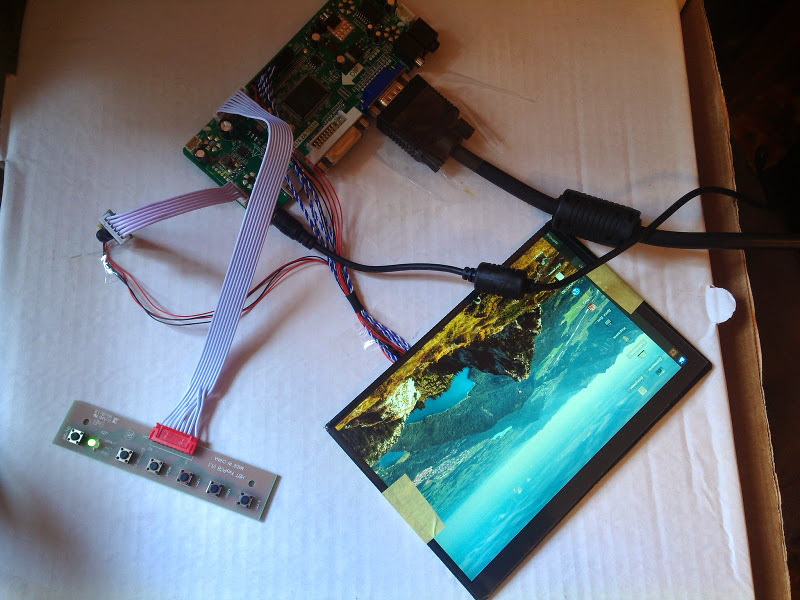
Riveted glasses. Unfortunately, they turned out very uncomfortable and pressed on the nose. But further plans were still Napoleonic.
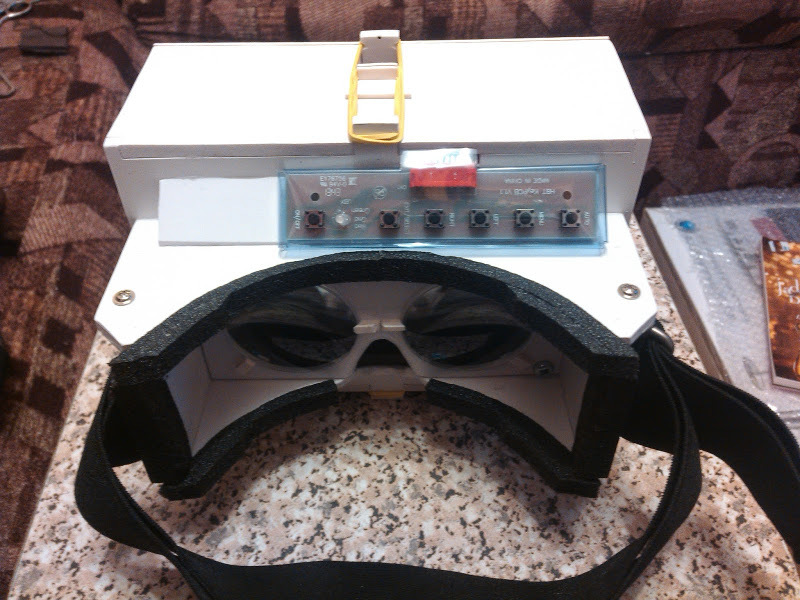
When there was no Oculus Rift DK2, and I didn’t want to bother with gyroscopes and accelerometers, I planned to turn the head through a webcam. Moreover, the webcam would give not only turns, but also head movements in space. Then I still did not understand that even the smallest delays when cornering very much kill the sense of immersion. Sometime later I tried the Oculus Rift DK2 and the sensations were unsurpassed. All the work on every little thing (no delays, no stretching images from the edges, head movement in space, high-quality display, etc.) gave a chic result of feeling inside. Of course, I understood that I was standing in the middle of a shopping center, but the immersion in the hills in the middle of the castle was excellent. Most of all for some reason, I remembered the distance. The mountains in the distance were felt right there - in the distance. I would love them and admire.
Plans were plans, but everything was stalled again. I usually try not to torture myself with all sorts of motivational things. If it is not going, then something is wrong with it. The glasses were thrown again, but thoughts continued to spin.
Then suspicions crept up that all the current options for points would not justify themselves. They will not be used everywhere. Only true fans will be immersed in another world, the world of BP. And that's why:
I divide BP into active and passive. Active BP is all mainstream now. In it, the human body is used to repeat movements within the BP. It is easy and simple. But this also kills the widespread use of such BP. Passive BP is, roughly speaking, the matrix of the same film. In such a BP, the body remains motionless, the BP device works with the brain.
Why the active BP will not be used everywhere, such as keyboard + mouse + monitor? Zulin (an observer of indie games) once said about the Nintendo Wii that waving a stick in Zelda is, of course, fun and there is a certain wow effect, but this, firstly, quickly bothers, and secondly, you get tired. By “tired,” I understand that to dive into a game you don’t have to swing a stick at all, minimal fingers are enough on a gamepad. So Zulin said that as soon as a stick-fly would bother, you take a gamepad and with no less pleasure you continue to play like that. Active BP certainly gives a powerful wow effect, but this is temporary, and if the game itself is interesting, then it will most likely continue to play on the monitor. Active BP is just an attraction.
You can consider another example - reading a book. I read fiction infrequently, but I noticed an interesting moment. Reading, in contrast to TV and computer games, gives the greatest sense of immersion. I suspect that this is due to a greater concentration. The brain needs to accept information in the form of letters, process and build a picture. And here is an important point that I realized - for such a concentration, the brain has to disconnect from the outside world (surely many of you or your friends plunged into reading so that they didn’t notice anything around you until they fit and do not poke a finger). From here it can be traced that an important point for BP is a qualitative disconnection from the outside world. You need to isolate yourself so that only the impact from the BP device remains. When the brain will receive only what it should receive, and not all external influences, then it will believe only in the incoming information. Passive BP, in which this principle applies, is the true future BP that will be used everywhere. Of course, I understood that the matrix was far away and that in this life I could not see it, but I had to do something. With these thoughts, the construction of a new BP device began.
I did not want to make glasses, but I wanted something like a BP chair. I wanted comfort, because all these wires only interfere. I just wanted to sit down, lower the lid on myself and use it. Plus, such a chair would provide not only ready comfort, but also isolation from the outside world. Began the search for other ways to obtain immersion in BP. One of these options was the overlay of the grid on the screen - the so-called barrier parallax, which is used in the Nintendo 3DS.



To implement this idea, transparent sheets were purchased for printing on a laser printer. But he quickly refused this idea, because: it is very difficult to catch the desired distance between the grid lines; the head should be at a certain point from the monitor; at close distances to the monitor, the effect translates into a rainbow. I still thought a lot, but did not invent anything. Therefore, he persuaded himself to return to the points.
This time he focused on comfort. There were preliminary versions of cardboard.
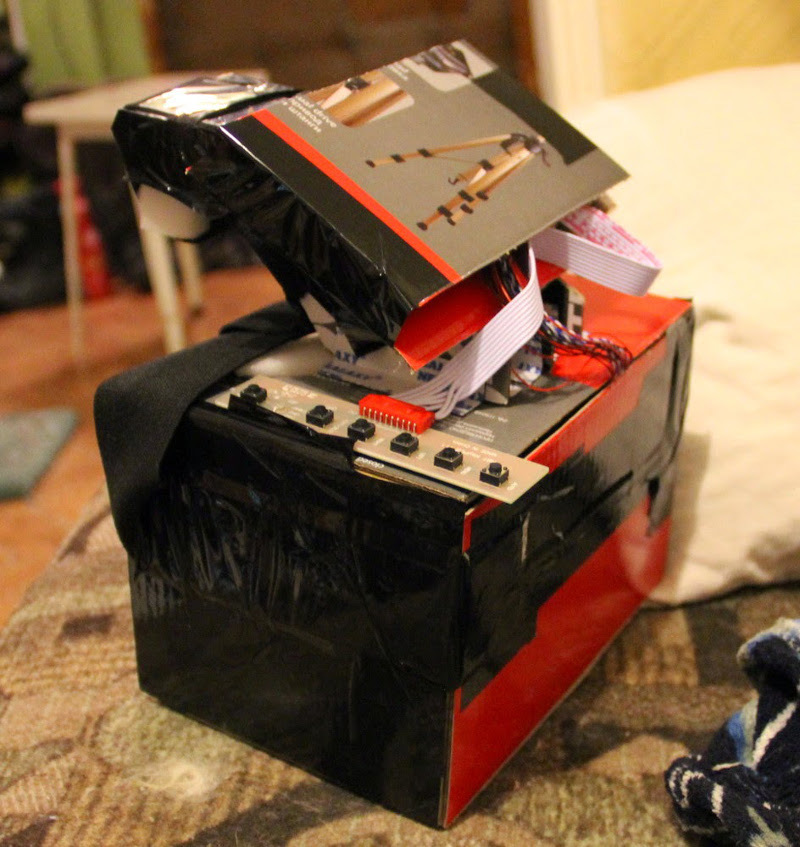

And even made a mirror insert, which simulated a review of the entire field of view of the eye. In principle, it works if you do not pay much attention to the edges, because there the image moves in the opposite direction.

This update has decided to use further.
And finally, he built new glasses. They covered the whole face and even made a call on the forehead. And oh yeah, they turned out to be comfortable.
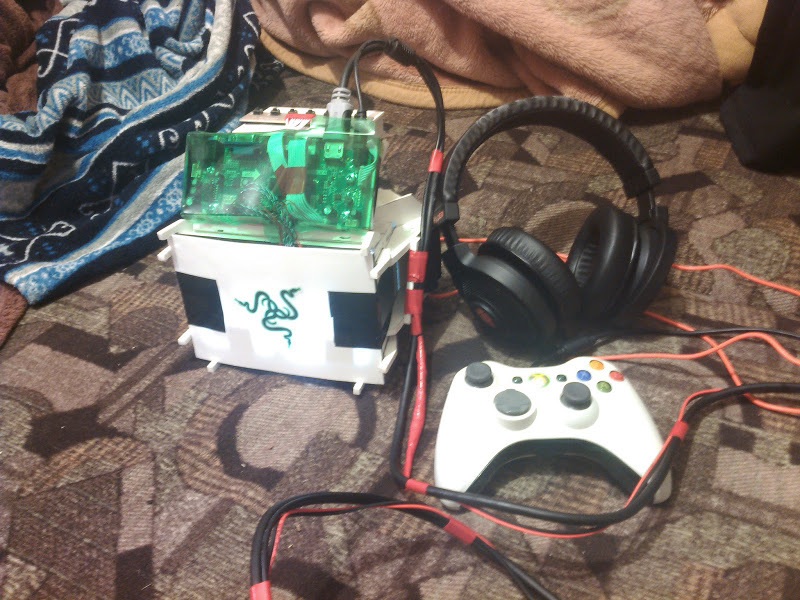
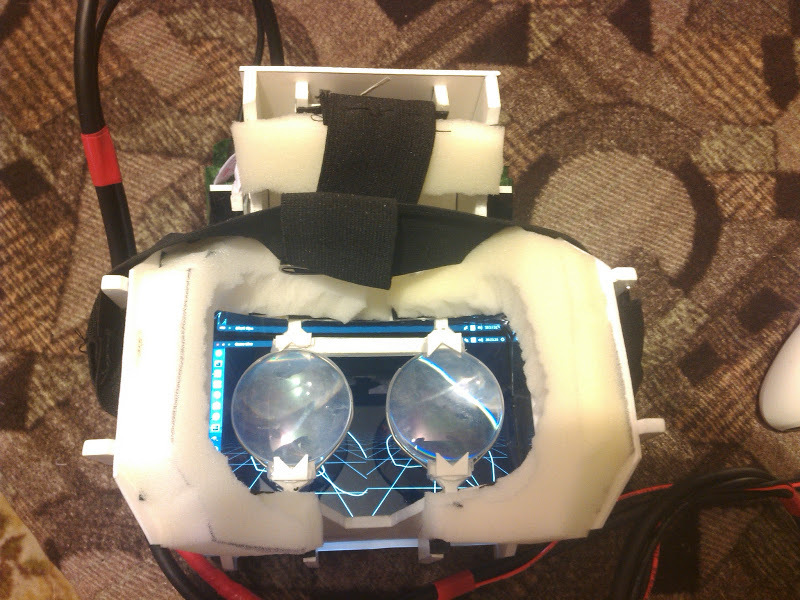
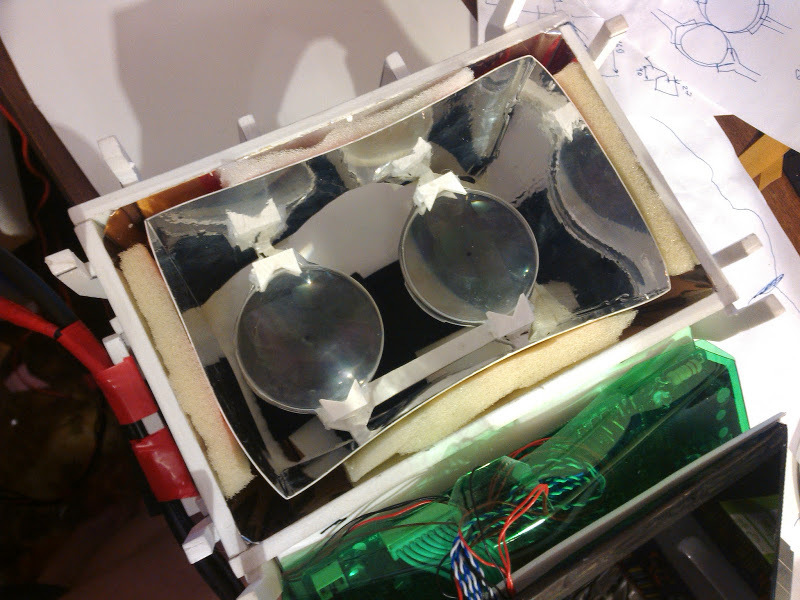
The idea of using such glasses was to turn off the body to the maximum and concentrate on what is happening on the screen. For this case, did not spare the money on headphones Razer c passive noise reduction. Noise, they certainly crush, but still not as good as expected. By the way, once I even conducted an experiment when, with the help of ear plugs, building headphones, swimming goggles dyed black, I plunged myself into “emptiness”. I lay there for two hours, not moving and not receiving information from the outside. I expected the brain to start modeling all kinds of images and pictures, but there was emptiness and anxiety. In general, this is not a long time to sit and as a result, the results were negative. But negative results are also results.
But back to the points. I tried to use them at night, when there are no extraneous noise, light, or movements. Usually I was lying on the couch just running in my demos, using a gamepad for this. I wanted to achieve a certain effect of sleep, so that the body really turned off, and the brain believed in the picture on the screen, as in a dream. Ideally, the gamepad would be replaced with the management of thoughts, in order to completely immobilize all parts of the body. This is all difficult. Only once I managed to achieve the effect that I did not look at the ceiling, but parallel to the floor. I really felt that I was looking parallel to the floor. This meant that the idea worked, but great efforts were needed to achieve it. It is because of this that these points were thrown.
I was disappointed. Life again flowed its ordinary. After all, so wanted exactly high-quality immersion. In order not just to have a wow effect, but to almost live there and create your own world, as in the dream of the film “The Beginning”. At the moment, active BP creates a good immersion, but due to its characteristics it cannot give what I want. Immersion in BP should be how to lie down and fall asleep, rather than jumping all over the room with sticks in your hands.
After some time again, I thought that since I couldn’t create a good dive, I had to at least make something portable so that I was always with me. A little world that is always with you. These thoughts were also caused by the fact that I work in a factory, where, except as phones, nothing can be carried. And of course I don’t understand why glasses for mobile devices are so bulky. No new reliable expectations were placed on the new glasses. Rather, they were made for the sake of fun, just to make such a design.
In these glasses I indulged with Minecraft through the stream via Wi-Fi, wrote my very small applications using a gyroscope, an accelerometer. The image jumped, jumped, was delayed at turns, but it worked. Perhaps the most wow sensations received from these glasses, for the first.
After some time, everything calmed down, scored points, but comrade with gamedev inspired new feats. He suggested that our narrow-eyed neighbors can order all the components to create a computer version of BP glasses. I ordered only the display 7 "1280x720 IPS. With all sorts of gyroscopes, accelerometers did not bother.

Riveted glasses. Unfortunately, they turned out very uncomfortable and pressed on the nose. But further plans were still Napoleonic.

When there was no Oculus Rift DK2, and I didn’t want to bother with gyroscopes and accelerometers, I planned to turn the head through a webcam. Moreover, the webcam would give not only turns, but also head movements in space. Then I still did not understand that even the smallest delays when cornering very much kill the sense of immersion. Sometime later I tried the Oculus Rift DK2 and the sensations were unsurpassed. All the work on every little thing (no delays, no stretching images from the edges, head movement in space, high-quality display, etc.) gave a chic result of feeling inside. Of course, I understood that I was standing in the middle of a shopping center, but the immersion in the hills in the middle of the castle was excellent. Most of all for some reason, I remembered the distance. The mountains in the distance were felt right there - in the distance. I would love them and admire.
Plans were plans, but everything was stalled again. I usually try not to torture myself with all sorts of motivational things. If it is not going, then something is wrong with it. The glasses were thrown again, but thoughts continued to spin.
Then suspicions crept up that all the current options for points would not justify themselves. They will not be used everywhere. Only true fans will be immersed in another world, the world of BP. And that's why:
I divide BP into active and passive. Active BP is all mainstream now. In it, the human body is used to repeat movements within the BP. It is easy and simple. But this also kills the widespread use of such BP. Passive BP is, roughly speaking, the matrix of the same film. In such a BP, the body remains motionless, the BP device works with the brain.
Why the active BP will not be used everywhere, such as keyboard + mouse + monitor? Zulin (an observer of indie games) once said about the Nintendo Wii that waving a stick in Zelda is, of course, fun and there is a certain wow effect, but this, firstly, quickly bothers, and secondly, you get tired. By “tired,” I understand that to dive into a game you don’t have to swing a stick at all, minimal fingers are enough on a gamepad. So Zulin said that as soon as a stick-fly would bother, you take a gamepad and with no less pleasure you continue to play like that. Active BP certainly gives a powerful wow effect, but this is temporary, and if the game itself is interesting, then it will most likely continue to play on the monitor. Active BP is just an attraction.
You can consider another example - reading a book. I read fiction infrequently, but I noticed an interesting moment. Reading, in contrast to TV and computer games, gives the greatest sense of immersion. I suspect that this is due to a greater concentration. The brain needs to accept information in the form of letters, process and build a picture. And here is an important point that I realized - for such a concentration, the brain has to disconnect from the outside world (surely many of you or your friends plunged into reading so that they didn’t notice anything around you until they fit and do not poke a finger). From here it can be traced that an important point for BP is a qualitative disconnection from the outside world. You need to isolate yourself so that only the impact from the BP device remains. When the brain will receive only what it should receive, and not all external influences, then it will believe only in the incoming information. Passive BP, in which this principle applies, is the true future BP that will be used everywhere. Of course, I understood that the matrix was far away and that in this life I could not see it, but I had to do something. With these thoughts, the construction of a new BP device began.
I did not want to make glasses, but I wanted something like a BP chair. I wanted comfort, because all these wires only interfere. I just wanted to sit down, lower the lid on myself and use it. Plus, such a chair would provide not only ready comfort, but also isolation from the outside world. Began the search for other ways to obtain immersion in BP. One of these options was the overlay of the grid on the screen - the so-called barrier parallax, which is used in the Nintendo 3DS.



To implement this idea, transparent sheets were purchased for printing on a laser printer. But he quickly refused this idea, because: it is very difficult to catch the desired distance between the grid lines; the head should be at a certain point from the monitor; at close distances to the monitor, the effect translates into a rainbow. I still thought a lot, but did not invent anything. Therefore, he persuaded himself to return to the points.
This time he focused on comfort. There were preliminary versions of cardboard.
And even made a mirror insert, which simulated a review of the entire field of view of the eye. In principle, it works if you do not pay much attention to the edges, because there the image moves in the opposite direction.

This update has decided to use further.
And finally, he built new glasses. They covered the whole face and even made a call on the forehead. And oh yeah, they turned out to be comfortable.



The idea of using such glasses was to turn off the body to the maximum and concentrate on what is happening on the screen. For this case, did not spare the money on headphones Razer c passive noise reduction. Noise, they certainly crush, but still not as good as expected. By the way, once I even conducted an experiment when, with the help of ear plugs, building headphones, swimming goggles dyed black, I plunged myself into “emptiness”. I lay there for two hours, not moving and not receiving information from the outside. I expected the brain to start modeling all kinds of images and pictures, but there was emptiness and anxiety. In general, this is not a long time to sit and as a result, the results were negative. But negative results are also results.
But back to the points. I tried to use them at night, when there are no extraneous noise, light, or movements. Usually I was lying on the couch just running in my demos, using a gamepad for this. I wanted to achieve a certain effect of sleep, so that the body really turned off, and the brain believed in the picture on the screen, as in a dream. Ideally, the gamepad would be replaced with the management of thoughts, in order to completely immobilize all parts of the body. This is all difficult. Only once I managed to achieve the effect that I did not look at the ceiling, but parallel to the floor. I really felt that I was looking parallel to the floor. This meant that the idea worked, but great efforts were needed to achieve it. It is because of this that these points were thrown.
I was disappointed. Life again flowed its ordinary. After all, so wanted exactly high-quality immersion. In order not just to have a wow effect, but to almost live there and create your own world, as in the dream of the film “The Beginning”. At the moment, active BP creates a good immersion, but due to its characteristics it cannot give what I want. Immersion in BP should be how to lie down and fall asleep, rather than jumping all over the room with sticks in your hands.
After some time again, I thought that since I couldn’t create a good dive, I had to at least make something portable so that I was always with me. A little world that is always with you. These thoughts were also caused by the fact that I work in a factory, where, except as phones, nothing can be carried. And of course I don’t understand why glasses for mobile devices are so bulky. No new reliable expectations were placed on the new glasses. Rather, they were made for the sake of fun, just to make such a design.
Reflections on the design took about two months. Every day, the head gave out some new ideas and rejected old ones. Initially, it was generally planned to give everything to 3D printing, but the price would have resulted in about 6,000 r and any improvements would have to be sent back to print. And I'm lazy and did not want to bother with it all. Yes, and the original version generally included gears and was much more complicated than the current one, so the refusal of 3D printing provoked brain activity to think through a simpler design.
I will describe the manufacturing process not as an instruction, but as a story, for there have been changes that are not consistent with previous actions.
Accessories include:
1. Plastic from foamed pvc 5 mm thick (not in the photo).
Such plastic is commonly used in advertising. Bought at the store selling materials for advertising. Excellent cut, processed and at the same time quite durable. A square meter cost me 700 rubles. Although it takes much less for glasses, I took it for the future. Before that I tried all sorts of different plastics, but this is the only one with which it is comfortable to work.
2. Antennas for radio.
For a piece I gave 120 r, and I need 4 of them. I think it's expensive. They will act as a sliding mechanism.
3. Lenses from loupes NoName Made In China.
They do not even indicate the multiplicity, but I choose empirically. Or to say in other words, by fitting. I take a magnifying glass in a store, hold it to my eye and look through the lens on my palm. I try on how much area is included in the review, and the approximate distance from the lens to the palm. For a piece 70 p.
4. Clips. Diameter in cross section of about 1 mm
Will serve as axes.
5. Microfiber fabric.
I want to use it as an external case. Since the glasses will fold, the body must be elastic. And while not passing light. Microfiber for wiping optics is suitable for this role almost perfectly. It is thin and dense. Light almost never misses. A cloth measuring 25x25 cm cost me 120 rubles. According to my calculations it should be enough.
6. And of course the most important thing is the telephone.
This is the most expensive of all the components and the heart of glasses. ZTE Grand S2 for 14,500 p. The criteria by which the device was chosen is the screen - 5.5 "and FullHD (1920x1080). Of course it's a pity for money, but, if anything, it will not disappear.

More would like to talk about the phone. Prior to this, on previous glasses, the display sizes were 7 ". Somehow I didn’t think much about choosing this size, but only when choosing a phone came the simple truth - 5.5" is ideal for my 61 mm interpupillary distance. The 5.5 "width of the screen is 122 mm, which is exactly half the interpupillary distance. Why didn’t I think about it before, I don’t know. FullHD of this phone is quite enough for a decent picture, and there’s no gap between the pixels.
And I would also like to tell you about a fictitious way to accurately determine the interpupillary distance. Although most likely this method did not know just me alone, but still. Before that, I either myself in front of the mirror, or asked someone thread to measure the distance between the pupils with a ruler. Of course there will be a big error. Firstly, the look is not parallel, and secondly, the measuring person also cannot be accurately perceived. Sometimes it happened that the distance reached 65 mm. My method is as follows: you need to take a piece of paper (preferably harder); mark on it several pairs of points that are 58, 59, 60, 61, 62 mm apart, and so on; make holes with the needle in the planned places; look at the distant object through each pair of holes. The pair in which the distant object is in the center of the holes is yours.
Like any development of new glasses, this one started with the construction of a 3D model.



The 3D model does not contain all the elements, but is built in order to determine the basic performance of the structure, the general appearance and whether there are any intersections of the material. Well, even then you will not have to bathe with drawing the dimensions of the parts, but you can simply print on a 1: 1 scale projection of these parts, cut and transfer to plastic.
As you can see, the design mainly consists of a frame for the phone, a frame for lenses, two arms, side panels for the frame, side panels for arms and four telescopic elements. It was assumed that the form in the form of real glasses would allow using them even without removing the caps (if there is one).
I will not give the dimensions of the parts. I will leave only at the end of the publication a link to the 3D model, which can be opened by the CAD program “Compass 3D” version no less than 12. There will also be attached a drawing file for the same Compass, which can be printed 1: 1 and get what I said above .

It is also worth noting that the size of the structure will vary depending on the lenses used (focal length), interpupillary distance, and head size.
As already repeated several times, I printed out the sketches and transferred to plastic. Here it is necessary to note one feature of plastic. In theory, its structure should be isotropic, but in fact it has some fibers. It turns out that in one direction plastic is hard, and in the other it bends easily enough. This feature must be considered for longitudinal structural elements.
With the help of a clerical knife, everything is easily cut.
Cut perfectly, as usual, failed, so everything was adjusted to the desired size with files and sandpaper. He did this not immediately with all the details, but gradually as they were connected to each other.
Superglue stuck the sides to the frame under the phone and the bows.
From the entire telescopic antenna is required only two knees. One of them should be 5 mm in diameter in cross section for the thickness of the plastic. With the help of an engraver with a cutting disc, I cut off the back of the antenna and the front part that was not needed. Through the ass pulled the right knee.
And so on all four pieces.
The resulting short antennas have so far been set aside and proceeded to recess on the arms with round and semi-circular needle files for these antennas.
Then on the superglue stuck shortened antenna in the grooves. But the glue does not keep this whole thing very well, so I rewound it with tape too.
Now you need to connect the arms with a frame under the lens. To do this, with the help of the same engraver with a disc, I made grooves in the sides of the arms.
He inserted the axes into the grooves just made, dropped it with superglue and pressed one of the sides under the radius. The radius is needed so that the corner does not interfere with the rotation of the arches. As the axes successfully approached the uppermost antenna elements.
In the frame under the lens did the response grooves. Engraver and needle files.
He connected the arms with the frame, inserted the axes into the grooves, dropped it with superglue and, until the glue dried, put plastic pieces on top. You can not be afraid that the axles stick tightly. All in the end is movable.
It can be seen that a couple of pieces of plastic are glued on the right bow. This is done so that when opening, the handle does not go further than it should be, i.e. to open exactly 90 degrees. On the left bow this is not required, because this, so to speak, is provided in the machine due to the fact that this bow is closer to the frame (in the closed state).
Now you need to somehow connect the resulting structure with a frame for the phone. This will help the clips that I bent, as in the pictures. Wavy ends should be inserted into the ends of the antennas.
Before inserting the clips at the ends of the antennas, an engraver with a disk cut the grooves so that the clip would come out as if from a cylindrical part. This is necessary so that the ends of the antennas rest on the ends of the side frames of the frame for the phone. After slotting, he inserted the clips into the ends of the antennas and inside he poured everything with hot-melt glue. Of course, it is better to pour some glue on the thread and wait a day, but I did not want to wait. Hot-melt glue didn’t really want to climb there, quickly cooled down, blocked the passage and all subsequent portions went out through the slotted antenna groove. I had to get the iron, reheat the antenna and push the hot melt on.
Since my hands do not grow from there, the arms were a little further from each other. And the grooves in the sides of the frame for the phone had to be done on the side, and not on the ends. If the grooves are made at the ends, then the arms during assembly of all the structures will not stand parallel to each other, which is very bad.
He put the clips into the grooves and stuck it on the superglue on top with plastic.
I thought for a long time how to fix the lenses, and in the end I decided to use the simplest option, namely, to cut the grooves with an engraver with a disk and press the lenses into these slots.
As a result, this construction was previously obtained. Another little plastic for mounting the phone and you can use it.






But it was not as rosy as planned. The phone even weighs only 150 grams, but it weighs heavily on the nose. And from the ears the bows slide off. I decided to use the material of a siliconized ball in order to alleviate the pressure on the nose and to eliminate slipping from the ears.
At the same time for silicone under the nose had to cut a groove in the shackle for normal closing structure. All the same engraver with the disc.
The bows really stopped slipping from the ears, but here the nose still endured unbearable pressure. I had to give up the idea of making glasses like glasses and apply a rubber over my head.To do this, cut off part of the arms, cut through the grooves, made a hole in the frame for the lenses and tied everything together with a rubber band for underwear.
To my surprise, the resulting design has become at times more convenient and more convenient all previous points.
It remains to sew light-proof elastic body from fabric. For this, my 25x25 cm piece was cut in half, stitched into a ribbon and cut off the excess, giving shape to the face.
Oddly enough, the length ideally went under the perimeter of the frame. Next, the fabric is glued to both frames. Pasted on the ends at the usual time and kept the day. At the same time, the display has pulled out a certain distance from the lenses, which provides focus on the screen image. And even a little further to eventually be able to adjust the focus. I had to hem the pieces under the lower part of the face, for I hurried, but on the whole everything is fine. Next to the fabric, I sewed headphones on and that's it.
And you can still take a look at the video in which I tell about the characteristics and show how the glasses are laid out.
Well that's all. I believe that the design, although it looks careless, was a success. The most important thing is that it sits on the head easily and fairly well. In this important role played by the bow. Telescopic antennas provide rigidity and the ability to adjust the focus. Points folded out turned out:
- 35 mm in thickness;
- 180 mm in width;
- 85 mm in height;
- weighing 320 grams (150 grams of which is a telephone).
With such sizes, they easily fit in any bag or even pocket.
Now you can carry your little world with you wherever you want. The main thing is that the sockets are nearby, if you understand what I mean. In principle, I have plans for these points and even a gamepad for mobile devices has already arrived. If there is a need, then laziness will overpower. But for now I will not get ahead.
And, as promised, a link to a file with a 3D model.
And even a little information from curiosity: it took about 12 hours to prepare the materials for this article and to write it. Lots of.
Source: https://habr.com/ru/post/368967/
All Articles